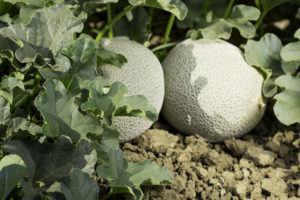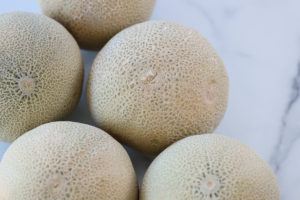Picking the Perfect Cantaloupe – Tips on new variety selection, ripening and at home safety practices
A lot has changed in the cantaloupe growing world. Growers are planting new varieties that behave much differently than the old, traditional cantaloupe varieties – particularly those grown in California.
The primary type of cantaloupe that used to be grown in California was known as a Western Shipper-type cantaloupe.
Western Shipper cantaloupe are very aromatic and they ripen after they’re picked. They also have a shorter shelf life and fewer of them are being planted every year.

Most grocery stores now have waste reduction policies and they are looking for every possible way they can to reduce the amount of food they throw away. Produce is one area where waste is high. As a result, retailers are now demanding cantaloupes that have longer shelf-life and a harder exterior. These cantaloupes can better withstand long-distance shipping. Even more importantly, these new long-shelf-life varieties allow retailers to meet their goals to reduce food waste.
So, what you will likely find at grocery stores today is one of several new kinds of cantaloupe varieties that are bred to have longer shelf life.
What’s different about these new LSL (Long Shelf Life) and ESL (Extended Shelf Life) cantaloupes is they are picked at peak ripeness and they produce very little if any ethylene. So, they won’t ripen or get softer after they are harvested.
Plant breeders are doing their best to create new LSL and ESL varieties that are sweet. Many new varieties have really good flavor, but you may notice the flesh is firm and its exterior shell is hard. This is exactly how these cantaloupes are bred and that firm flesh is why it lasts so much longer.
In California, the California Cantaloupe Advisory Board has set a minimum sugar requirement for these new melon varieties to help ensure consumers have a good eating experience. California cantaloupe farmers are required to test their melons for sugar content before they harvest and they must have no less than 12 brix (brix is a measurement of sugar content) when they are harvested. Many varieties are actually harvested at closer to 14 or 15 brix. So, they can be very sweet.
So, what should we look for when we are selecting these new cantaloupe varieties when we go to buy one at the store?
Well, first of all, color can be a good indicator of maturity, so looking for that cream color is something you can do. But, in truth, many of these new varieties have a much more greenish cast to them than did the older, traditional varieties.
Probably the best indicator is to look at what’s called the “blossom” end of the cantaloupe – that is the end that is opposite from the stem end. You want this to be a bit soft to the touch. And, in fact, if you see that it’s starting to crack a bit – that is actually a good thing and it means the fruit is mature.

You can also look at the stem end. With those old Western Shipper varieties, when the fruit was mature, the melon would naturally slip away from its stem. This was an indicator of maturity – so you would see a nice smooth surface with no hint of stem.
With these new ESL and LSL varieties, the stem does not slip away – so you are going to have a bit of a piece of the stem that is likely still attached. That’s OK – and what you want to look for here is if the ‘netting’ is growing up on to the stem. That is another sign of maturity.
Ok – so now that you know how to select one of these new varieties – we will tell you the good thing about them – they will last up to three weeks in your refrigerator. So, you have a much longer time to eat them. And, in fact, these can last up to a week without any refrigeration. But we do recommend that you refrigerate them – and most definitely you need to refrigerate cantaloupe after it’s cut.
So remember, these are the top traits you should look for in a ripe cantaloupe:
- Blossom end that is slightly softer and starting to crack
- Some netting growing up the stem
- Creamy color – but they can have more of a green caste
It is also important to always follow safe handling and storing guidelines after you bring cantaloupe home from the grocery store. Alway remember to:
- Wash cantaloupe with running water before cutting into it. Use a scrub brush to thoroughly clean the rind.
- Use a clean knife and cutting board when preparing cantaloupe to prevent contamination from other food.
- After cutting, store cantaloupe in the refrigerator in plastic wrap or a sealed container.
California cantaloupe farmers work hard to provide consumers with the safest melons in the world. California cantaloupes are grown under a stringent food safety program that requires growers to pass a government food safety audit with 180 different checkpoints in their fields and another 150 checkpoint audit in their cooling facilities. Since California cantaloupe growers are doing their part to keep melons safe please do your part by following the simple handling and storing guidelines above.







